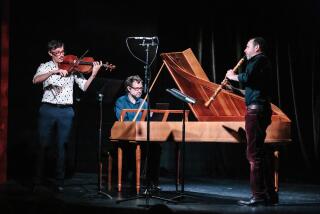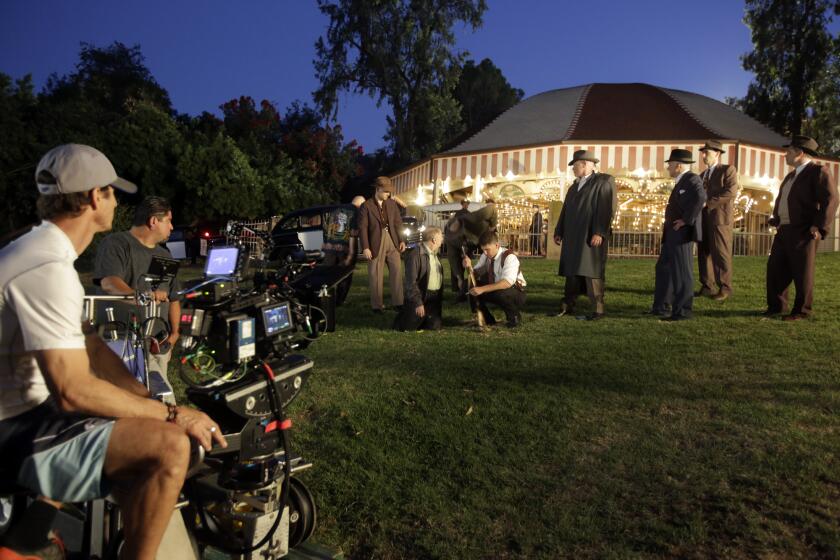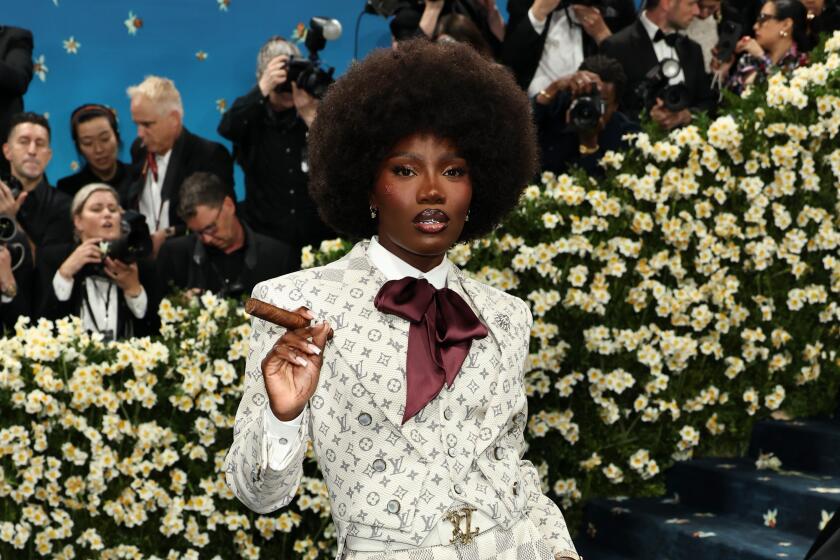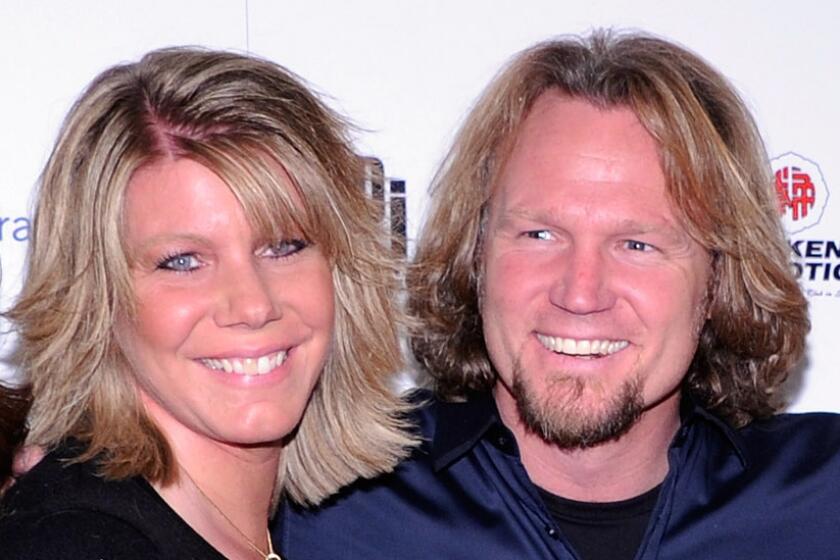No Barbers, No Shops
- Share via
Shave and a haircut, two bits? The Masters of Harmony may sing it that way, in a time-warping, four-part blend, but they know better. They are not your great-grandfather’s barbershop singers. Sweet Adeline has met Fantastic Sam.
“We’re not a bunch of guys who happened to gather on a corner and started singing under a light pole,” advises Dan Fullerton, 59, of Brea, musical vice president for the chorus.
Or around a barber chair, for that matter.
“I can’t say I have ever sung in a barbershop,” says Dave Briner, 69, of Anaheim Hills, who arranges many of the songs. “But it’s debatable whether the music really started in barbershops, anyway. It’s feasible, but I think it’s a fanciful myth.”
So-called barbershop music derives from the late 1800s, when entertainment tended to be self-generated rather than gleaned from movies or television, radio or computers. Places of public socializing--barbershops, for instance--were places where people might break into song.
But the Masters of Harmony know what time it is. The 135-member chorus recently won its third international championship in six years.
The Masters of Harmony employ a style that fits right in with this summer of Dream Team basketball at the Olympics, special effects and superheroes at the movies and the status quo at national political conventions.
Imagine Charles Barkley warbling “Wait Till the Sun Shines, Nellie” under a flat-brimmed straw hat. Or Arnold Schwarzenegger intoning “Down by the Old Mill Stream” in a bow-tie and white shirt with garters above the elbows. Or bottom-line political conventioneers singing “For He’s a Jolly Good Fellow” dressed, uh, well, the way political conventioneers dress. Anyway, that’s how the Masters of Harmony approach a barbershop song.
“We sing to win,” said Fullerton, retired after 26 years in the Air Force. “We established a plan to get the gold medal 1 1/2 years ago, and we followed it.”
They left little doubt about the outcome of last month’s competition in Salt Lake City, earning a score of 98 on a 100-point scale.
“After 10 or 12 measures into our ballad, people knew we had won,” said Chris Joyce, 38, of Pomona. “When it was over, we received a standing ovation.”
Additionally, four members of the chorus--a group called Nightlife--emerged as the top barbershop quartet. It was only the second time in the 58-year history of the Society of the Preservation and Encouragement of Barbershop Quartet Singing in America that the same chapter won both categories.
The members of the quartet--Brett Littlefield, 32, of Brea; Rob Menaker, 36, of Gardena; Jeff Baker, 35, of Culver City; and John Sasine, 34, formerly of Brea and now of Salt Lake City--have sung together for six years. They have been finalists in the competition for the past four.
The most requested song when they perform? “Basin Street Blues.”
Baker figures it is probably also the song that put them over the top in the competition--it is a hit even with an audience stacked with other barbershoppers. That audience was 12,000 strong on the final night of the competition.
“I’m still wiped out. I haven’t been able to get back to 100%,” said Littlefield, who did double duty in the chorus and quartet. “But as physically taxing as it seemed, I realize it was mostly mental for us. Like athletes, it was a matter of keeping our heads in the game, every game, all they way through.”
Littlefield, who began barbershop singing at 16 when he was captain of the track team at Garden Grove High School, was among many members of the Masters of Harmony to draw a sporting parallel with his musical accomplishments.
“The Super Bowl of barbershop,” he called it.
*
The chorus is split about evenly between singers from Orange and Los Angeles counties, but it also draws from as far as San Diego and Santa Barbara. The director flies in from Phoenix each week for rehearsal.
In addition to three-hour rehearsals every Wednesday night, the Masters of Harmony are informed about proper diet and encouraged to participate in a physical conditioning program.
“The finals were in Salt Lake City, at an altitude of about 5,000 feet,” Fullerton pointed out. “We knew we would need stamina. We prepared for it. Our motto is: Dedicated to musical excellence. We’re just like the Oakland Raiders, except we win.”
Following its weekend victories, the group sang Sunday morning with the Mormon Tabernacle Choir. For a finale, the choir and chorus put their 460 voices together for “The Battle Hymn of the Republic.”
*
The Masters of Harmony formed in 1985 and made it to the international championships for the first time in 1989, finishing fourth. Since then they have won the gold medal every time they have been eligible--in 1990, 1993 and 1996. Champions are ineligible for two years after they win.
The drive for the gold begins in local competitions, progressing through the Southern California regional and Southwestern district levels. The Masters of Harmony are so intent on victory that each member of the chorus must re-audition before competition.
“Five men didn’t make it. Their performance was not up to standard, so rather than hurt our chances, we asked them to step down,” Briner said. “Maybe it sounds a little impersonal or harsh, but that’s the culture of this organization, and everybody knows it. Nobody’s surprised by it. They are still our friends.”
This approach may strike some as contrary to the culture of barbershop singing, born of man-on-the-street participation.
“Competition forces excellence in performance and therefore improves the art form,” countered Briner, who sang noncompetitively for 30 years before joining the Masters of Harmony. “I found that intense competition really floats my boat. But there’s room for everybody in barbershopping.”
Barbershopping may nearly owe its survival to competition.
The Society for the Preservation and Encouragement of Barbershop Quartet Singing in America was born in 1938 out of concern that movies and radio were destroying the art of four-part harmonizing.
The extended title of the organization was a jab at the alphabet soup agencies that proliferated during President Franklin D. Roosevelt’s New Deal. The SPEBSQSA, headquartered in Kenosha, Wis., has about 40,000 members worldwide.
The best of them, however, are in Southern California.
“This year was the most prepared we have ever been,” Fullerton said. “I knew it because when we began to sing I wasn’t at all nervous. We had peaked. We went out and gave the performance of our lives. We’re not called the Masters of Harmony for nothing.”
More to Read
The biggest entertainment stories
Get our big stories about Hollywood, film, television, music, arts, culture and more right in your inbox as soon as they publish.
You may occasionally receive promotional content from the Los Angeles Times.










